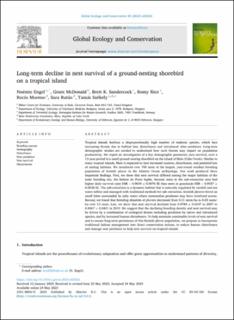| dc.contributor.author | Engel, Noemie | |
| dc.contributor.author | McDonald, Grant | |
| dc.contributor.author | Sandercock, Brett Kevin | |
| dc.contributor.author | Rice, Romy | |
| dc.contributor.author | Moreno, Rocio | |
| dc.contributor.author | Rataod, Sara | |
| dc.contributor.author | Székely, Tamás | |
| dc.coverage.spatial | Maio, Kapp Verde, Cabo Verde | en_US |
| dc.date.accessioned | 2023-06-05T13:18:01Z | |
| dc.date.available | 2023-06-05T13:18:01Z | |
| dc.date.created | 2023-05-26T13:17:59Z | |
| dc.date.issued | 2023 | |
| dc.identifier.issn | 2351-9894 | |
| dc.identifier.uri | https://hdl.handle.net/11250/3069969 | |
| dc.description.abstract | Tropical islands harbour a disproportionally high number of endemic species, which face increasing threats due to habitat loss, disturbance and introduced alien predators. Long-term demographic studies are needed to understand how such threats may impact on population productivity. We report an investigation of a key demographic parameter, nest survival, over a 13-year period in a small ground-nesting shorebird on the island of Maio (Cabo Verde). Similar to many tropical islands, Maio is expected to face increased tourism, disturbance, and potential loss of nesting habitats. We monitored over 700 nests of the largest, year-round resident breeding population of Kentish plover in the Atlantic Ocean archipelago. Our work produced three important findings. First, we show that nest survival differed among the major habitats of the main breeding site, the Salinas do Porto Inglˆes, because nests in the salt-extraction area had higher daily survival rates DSR = 0.9654 ± 0.0076 SE than nests in grasslands DSR = 0.9557 ± 0.0038 SE. The salt-extraction is a dynamic habitat that is naturally regulated by rainfall and sea water inflow and managed with traditional methods for salt-extraction. Kentish plovers breed on small islets surrounded by salty water where mammalian predators may have restricted access. Second, we found that breeding densities of plovers decreased from 0.11 nests/ha to 0.03 nests/ ha over 13 years. Last, we show that nest survival declined from 0.9784 ± 0.0107 in 2007 to 0.8967 ± 0.0401 in 2019. We suggest that the declining breeding density and nest survival may be driven by a combination of ecological factors including predation by native and introduced species, and by increased human disturbance. To help maintain sustainable levels of nest survival and to ensure long-term persistence of this Kentish plover population, we propose to incorporate traditional Salinas management into direct conservation actions, to reduce human disturbance and manage nest predators to help nest survival on tropical islands. Breeding success Demography Disturbance Nest predation Nest survival Macaronesia | en_US |
| dc.language.iso | eng | en_US |
| dc.rights | Attribution-NonCommercial-NoDerivatives 4.0 Internasjonal | * |
| dc.rights.uri | http://creativecommons.org/licenses/by-nc-nd/4.0/deed.no | * |
| dc.subject | Breeding success | en_US |
| dc.subject | Demography | en_US |
| dc.subject | Disturbance | en_US |
| dc.subject | Nest predation | en_US |
| dc.subject | Nest survival | en_US |
| dc.subject | Macaronesia | en_US |
| dc.title | Long-term decline in nest survival of a ground-nesting shorebird on a tropical island | en_US |
| dc.title.alternative | Long-term decline in nest survival of a ground-nesting shorebird on a tropical island | en_US |
| dc.type | Peer reviewed | en_US |
| dc.type | Journal article | en_US |
| dc.description.version | publishedVersion | en_US |
| dc.rights.holder | © 2023 The Authors | en_US |
| dc.subject.nsi | VDP::Zoologiske og botaniske fag: 480 | en_US |
| dc.subject.nsi | VDP::Zoology and botany: 480 | en_US |
| dc.source.volume | 45 | en_US |
| dc.source.journal | Global Ecology and Conservation | en_US |
| dc.identifier.doi | 10.1016/j.gecco.2023.e02522 | |
| dc.identifier.cristin | 2149593 | |
| dc.relation.project | Norges forskningsråd: 160022 | en_US |
| dc.source.articlenumber | e02522 | en_US |
| cristin.ispublished | true | |
| cristin.fulltext | original | |
| cristin.qualitycode | 1 | |

